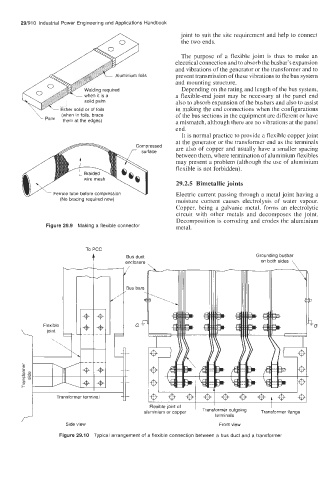Page 960 - Industrial Power Engineering and Applications Handbook
P. 960
29/91 0 Industrial Power Engineering and Applications Handbook
joint to suit the site requirement and help to connect
the two ends.
The purpose of a flexible joint is thus to make an
electrical connection and to absorb the busbar's expansion
and vibrations of the generator or the transformer and to
Aluminium foils prevent transmission of these vibrations to the bus system
and mounting structure.
Welding required Depending on the rating and length of the bus system,
a flexible-end joint may be necessary at the panel end
also to absorb expansion of the busbars and also to assist
Either solid or of foils in making the end connections when the configurations
(when in foils, brace of the bus sections in the equipment are different or have
Palm them at the edges) a mismatch, although there are no vibrations at the panel
end.
It is normal practice to provide a flexible copper joint
at the generator or the transformer end as the terminals
are also of copper and usually have a smaller spacing
between them, where termination of aluminium flexibles
may present a problem (although the use of aluminium
flexible is not forbidden).
29.2.5 Bimetallic joints
Ferrule tube before compression Electric current passing through a metal joint having a
(No bracing required now) moisture content causes electrolysis of water vapour.
Copper, being a galvanic metal, forms an electrolytic
circuit with other metals and decomposes the joint.
Decomposition is corroding and erodes the aluminium
Figure 29.9 Making a flexible connector metal.
To PCC
Bus duct
enclosure , Grounding busbar \
on both sides
Flexible
- -
LW +
*
m
t-
Transformer terminal - .-
i
2 Side view Front view
Figure 29.10 Typical arrangement of a flexible connection between a bus duct and a transformer

